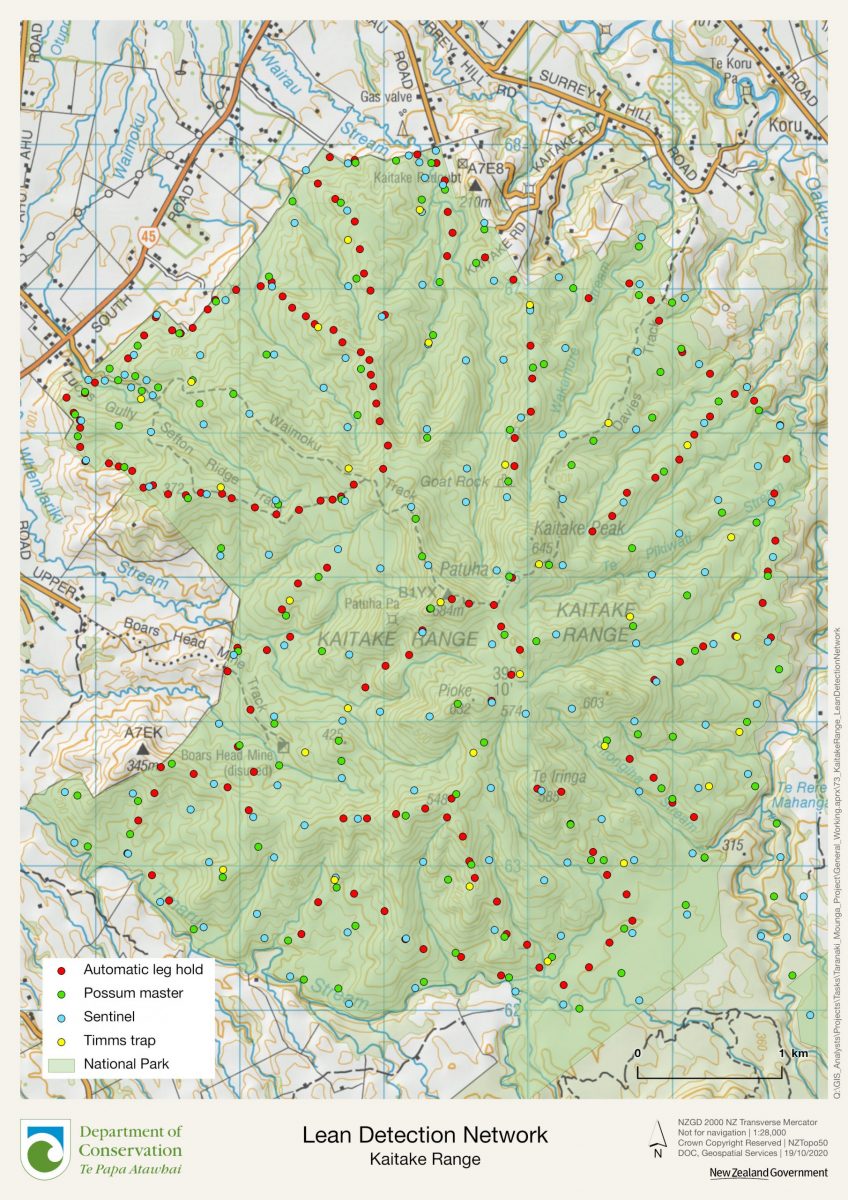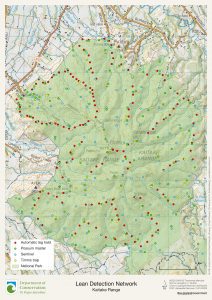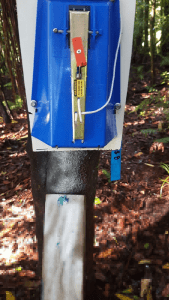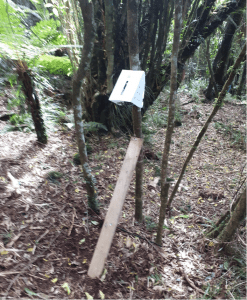Kaitake Range possum trap network
Lessons from our Kaitake Range possum trap network – Why not to use single set removal traps for possum eradication attempts?
By Tim Sjoberg, Taranaki Mounga Research and Innovation Lead
In 2016, the New Zealand government announced the ambitious aim of removing rats, possums and stoats from mainland New Zealand by the year 2050 (Predator Free 2050). To achieve this large-scale eradication, aerial tools are needed to remove predators from inaccessible and larger continuous forested landscapes. This, while follow up ground predator control tools to remove remnant animals. For this to be successful, the tools used need to be socially acceptable, cost effective and scalable.
In this summary we explore why single set removal traps will not achieve compete removal of possums from continuous forest in Taranaki and investigate other control tool options and their success to date.
Restore Kaitake is an ongoing pilot programme to completely remove possum from ~ 5000 hectares of land in and surrounding the Kaitake Range. This area includes 2,300 hectares of the Kaitake Range, 2,000 hectares of Kaitake farmland and Oākura town which includes residential properties, a school public reserves and walkways.
This project was initiated by Taranaki Mounga Project (TMP), Department of Conservation (DOC) and the Taranaki Regional Council (TRC) as part of the Taranaki Taku Tūranga – Towards Predator-Free Taranaki, with the overall lead being TRC. As part of this operation, TRC intensely controlled possums from the surrounding ~2,500 hectares of the Kaitake Range with wide range of methods (live capture trapping, removal trapping, bait stations and thermal assisted night predator control etc). While TMP undertook an aerial control 1080 operation to initially knock down possums, a removal trap network was actioned with the aim of removing any surviving possums.
The design of the network started in mid-2018, at this early stage in mainland eradication attempts by Predator Free 2050 (PF2050) we took lessons from past operations and the best available advice from technical advisors. The concept of installing one removal trap every 50 hectares was suggested to be sufficient to expose all possums (and hypothetically remove them) within a low-density possum landscape, as possum home range size increases dramatically after an effective aerial operation. To maximise operational success we decided to trial a high density trapping network. This consisted of 294 single set possum removal traps (143 Sentinal, 121 Possum Master and 30 Timms possum trap), set within a ~12.5 hectare grid covering the Kaitake Range and any surviving animals home range.
These three trap types were chosen because of their high capture rates, ease of service, different coloured materials, and previous history with minimal non-target by-catch. Care was taken to locate and install traps in the most suitable “trapping tree” within the constraints of steep country or inaccessible areas. Because of weather delays, some traps were installed and left unbaited up to 6 months before the aerial operations begin.
After the first application of the double (or dual) aerial 1080 operation had occurred and the detection network consisting of cameras (n = 63) and chew cards (n = 900, white corflute impregnated with lure) indicated a sufficient reduction of possums. We baited and set the removal trap network on the Kaitake Range to determine if we could remove the remaining possums without the need for the second stage of the aerial application.
Between the first and second aerial operation, we set all traps starting from seven days after the aerial application and finished 16 days after the application. Traps were baited with Connovation ‘smooth’ lure and flour blaze (5:1 flour and icing sugar lured with ~ 50 ml of Hansells peppermint essence). Both lures are industry standard and good attractants/bait to possums. This trapping network was serviced five times between day 16 to day 70 after the aerial application, with the average service time being 10 1/2 days. Each service consisted of refreshing the trap lure and flour blaze, chew cards and serving the cameras. The above-mentioned lure was used for the first four trap services, the last trap service was baited with a mixture of peppermint, cinnamon, mixed herbs held with a flour, icing sugar and sunflower oil matrix.
From the ~15,876 trap nights, this pilot network removed 18 possums over ~54 nights. We estimated 600 possums left within the Kaitake Range after the double (or dual) aerial 1080 operation was completed. When evaluated to the self-reporting leg hold network (installed since late-2019, using 190 leg hold traps), this network has removed 108 possums from the Kaitake Range over a 54 night periods between 1 May to 23 June 2020 (~10,260 trap nights). It should be noted that this trapping period occurred following New Zealand’s March/April 2020 Level 4 Covid-19 lockdown. During this time no leg hold traps were actively set to capture, meaning trap lure may have increased in novelty through a two month period of no trapping.
We hypnotise that the single set removal trap network was ineffective at removing possums compared to the leg hold network for several reasons. Firstly the instalment of traps (unbaited and unset) for long periods (up to six months) before setting live could have allowed the novity of the traps to diminish. A better approach might have been stashing traps near or at track junctions and setting on trees once aerial operation had been undertaken to increase novity for surviving possums. Secondly, the intensive use of chew cards might have caused a distraction to surviving possums as cards where positioned along all trap lines at 100 m intervals. Thirdly, the lures used were not attractive enough given the higher abundance of readily accessible food resources available to surviving possums after stage one aerial operation. And lastly, more animals were captured than found however these were removed by members of the public before staff serviced the trapline.
We place more weight to the first two options as subsequent possums have been caught on the Kaitake Range using the above-mentioned lures, also the small number(s) of traps cleared of animals by members of public would have little impact on the trap networks results (i.e. 18 possums over 15,876 trap nights versus 108 possums caught over smaller trap nights from the leg hold traps).
Ultimately, this trial demonstrates that traditional possum removal traps, even when deployed at high density (i.e. every 12.5 hectares), using three different trap types and baited with industry standard lures, will not completely remove possums from continual forests in Taranaki. We believe more sensitive control tools that require less manual bait refreshment need to be developed in order to achieve PF2050 for possums and although the self-reporting leg hold network is capturing possums at higher frequency than single set removal traps, the labour requirements of install and maintenance needs to be greatly reduced in order for this tool to be scalable.
The Taranaki Mounga Project would like to thank TPFT, DOC, along with our Taranaki Mounga ranges and the Kaitake community for being so accommodating as we carried out this work. These learnings have been shared with key research and predator control groups to help with their large-scale predator possum eradication operations from inaccessible and larger continuous forested landscapes.




